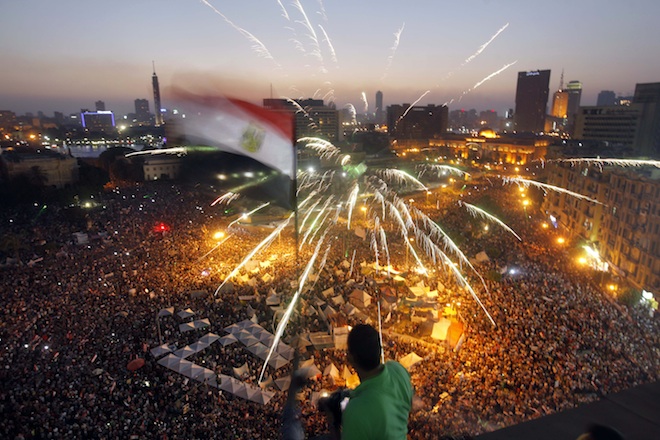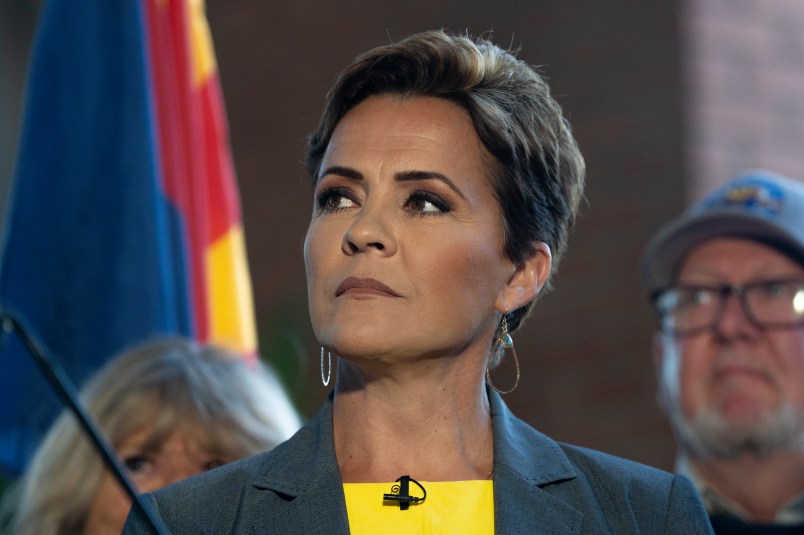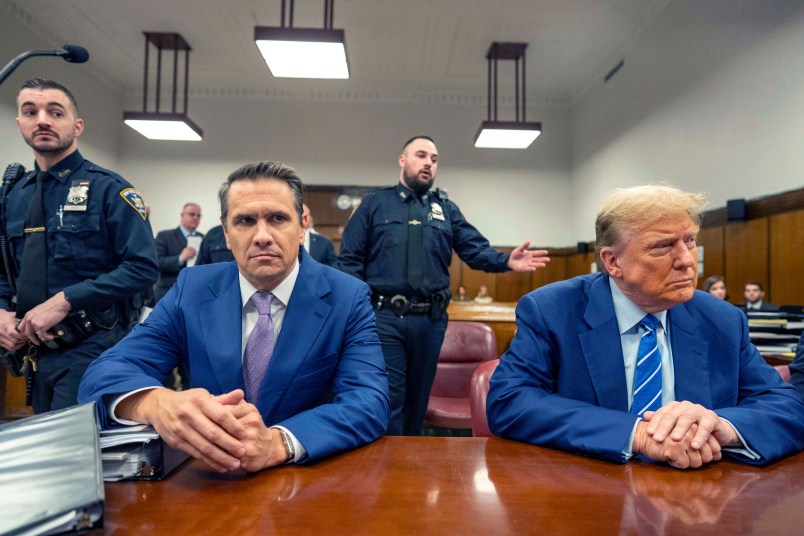CAIRO (AP) — Egypt’s military has given Islamist President Mohammed Morsi and opposition protesters until Wednesday afternoon to work out their differences, or the military will put forward its own road map. The ultimatum followed Sunday’s huge demonstrations against Morsi around the country. Hundreds of thousands gathered in city squares again Monday, demanding that Morsi resign. Morsi and his Muslim Brotherhood were resisting, noting that he is a democratically elected president who has served only one year of his four-year term.
Here are some key events from more than two years of turmoil and transition.
Jan. 25-Feb. 11, 2011 — Egyptians stage nationwide demonstrations against the rule of autocrat Hosni Mubarak, who led the country for nearly three decades. The 18-day “revolution,” launched by secular and leftist youth, draws in a wide spectrum, including the Muslim Brotherhood and other Islamists. Hundreds of protesters are killed as Mubarak and his allies try to crush the uprising.
Feb. 11 — Mubarak steps down and turns power over to the military. Two days later, the body of top generals, the Supreme Council of the Armed Forces, dissolves parliament and suspends the constitution, meeting two key demands of protesters.
March 19 — In the first post-Mubarak vote, Egyptians cast ballots on constitutional amendments sponsored by the military setting the framework for the transition to democracy, including scheduling the first parliamentary and presidential elections. Islamists back the amendments, eager to hold elections they are poised to dominate. Many revolutionaries push for a “no” vote, arguing a constitution should be written first. The measures are overwhelmingly approved.
Oct. 9 — Troops crush a protest by Christians in Cairo over a church attack, killing more than 25 protesters. The rally is one of many during the military’s nearly 17-month rule, with protesters often calling for the removal of the generals and clashes frequently erupting that killed dozens.
Nov. 28, 2011-Feb 15, 2012 — Egypt holds multistage, weekslong parliamentary elections, with Islamists winning big. In the lawmaking lower house, the Muslim Brotherhood wins nearly half the seats, and ultraconservative Salafis take another quarter. The remainder goes to liberal, leftist, independent and secular politicians. In the largely powerless upper house, few voters bother to cast ballots, and Islamists take nearly 90 percent of the seats.
May 23-24, 2012 — The first round of voting in presidential elections, with a field of 13 candidates. Morsi and Ahmed Shafiq, the last prime minister under Mubarak, emerge as the top two finishers, to face each other in a runoff.
June 14 — The Supreme Constitutional Court orders the dissolving of the Islamist-dominated lower house of parliament on grounds that a third of its members were elected illegally. The military swiftly closes down parliament.
June 16-17 — Egyptians vote in the presidential runoff between Morsi and Shafiq. The generals issue a “constitutional declaration” giving themselves sweeping authorities and limiting the powers of the next president. Morsi emerges as the victor, with 51.7 percent of the vote.
June 30 — Morsi takes his oath of office before the Supreme Constitutional Court, a day after reading a symbolic oath in Cairo’s Tahrir Square, birthplace of the revolution.
Aug. 12 — In a bold step, Morsi orders the retirement of the top Mubarak-era leadership of the military and cancels the military’s last constitutional decree, taking back the powers that the generals gave themselves. The move was seen as way to curb the military’s role in political affairs, but it also gave Morsi the power to legislate in the absence of parliament.
Nov. 19 — Members of liberal parties and representatives of Egypt’s churches withdraw from the 100-member assembly writing the constitution, created by parliament before it was dissolved. They say they are protesting attempts by Islamists who dominate the panel to impose their will on the draft.
Nov. 22 — Morsi unilaterally decrees greater powers for himself, giving his decisions immunity from judicial review and barring the courts from dissolving the constituent assembly and the upper house of parliament. The move came just ahead of court decisions that could have dissolved the bodies. The move sparks days of protests, with clashes between Morsi’s supporters and opponents. At one point, some 200,000 people rally in Tahrir Square, with some of the first chants for Morsi to “leave.”
Nov. 30 — In a marathon all-night session, Islamists in the constituent assembly rush to complete the draft of the constitution, with almost all non-Islamists boycotting the gathering. Morsi sets a Dec. 15 date for a referendum, fueling further protests.
Dec. 2 — Islamists protest outside the Supreme Constitutional Court, blocking judges from entering to rule on the legality of the constituent assembly.
Dec. 4 — More than 100,000 protesters march on the presidential palace, demanding the cancellation of the referendum and the writing of a new constitution. The next day, Islamists attack a peaceful anti-Morsi sit-in outside the palace, sparking street battles that leave at least 10 dead. Days later, Morsi rescinds his initial decrees, but maintains the date of the referendum.
Dec. 15, Dec. 22 — In the two-round referendum, Egyptians approve the constitution, with 63.8 percent voting in favor. Turnout is low, with only 32.9 percent of voters participating.
Dec. 29 — The Egyptian Central Bank announces that foreign reserves — drained to $15 billion from $36 billion in 2010 — have fallen to a “critical minimum” and starts new measures to stop a sharp slide in the value of the Egyptian pound. The pound’s decline slows but doesn’t stop, and now stands at just over 7 to the dollar, compared to as strong as 5.5 to the dollar in 2010.
Jan. 25, 2013 — Hundreds of thousands hold protests in Tahrir Square and nationwide against Morsi on the 2-year anniversary of the start of the revolt against Mubarak, and clashes erupt in many places. The following day, residents of the city of Port Said stage protests, angered by a court ruling convicting and sentencing to death a group of local soccer fans for a 2012 stadium riot. Police crack down hard in Port Said, killing more than 40 protesters, and the city and others nearby go into near revolt. Much of the anger is focused at Morsi, who praised the police for their crackdown.
Feb. 22 — Morsi schedules elections for a new lower house of parliament to begin in April. But the election is postponed after a court rules that the upper house — which is carrying out legislative duties until a lower house is created — improperly approved the law governing the election. It remains unknown when elections will be held.
Feb.-March 2013 — Protests rage in Port Said and other cities for weeks, with dozens more dying in clashes, and some police units around the country go on strike. Brotherhood youth and their opponents fight in the streets outside the group’s main Cairo headquarters.
April 7 — A Muslim mob attacks the main cathedral of the Coptic Orthodox Church when Christians hold a funeral and protest there over four Christians killed in sectarian violence outside of Cairo the day before. One person is killed in clashes at the cathedral, and Pope Tawadros II publicly blames Morsi for failing to protect the building, thought the president condemns the attack.
May 7 — Morsi reshuffles the Cabinet, bringing in more ministers from the Muslim Brotherhood to total 11 members of the 36-member government. Officials say the changes aim to finalize long-stalled negotiations with the International Monetary Fund for crucial $4.8 billion loan, which requires sensitive reductions to fuel and food subsidies that take up a large chunk of the budget. A deal on the loan has still not been reached.
June 23 — A mob beats to death four Egyptian Shiites in their home in a village on the edge of Cairo. Morsi condemns the attack, but critics blame virulent anti-Shiite rhetoric by his hard-line Islamist allies, fueled by Syria’s civil war. A week earlier, Morsi shared a stage with hard-line clerics at a rally, sitting silently as they denounced Shiites as “filthy.”
June 30 — Millions of Egyptians take to the streets in Cairo and other cities calling for Morsi to step down in a massive display of anger and frustration. The demonstrations are largely peaceful, although 16 people, half of them in clashes outside the Muslim Brotherhood’s Cairo headquarters, are killed in protest-related violence nationwide. Organizers vow to keep up the protests until Morsi resigns.
July 1 — Large-scale demonstrations continue, and Egypt’s powerful military gives the two sides 48 hours to resolve their disputes, or it will impose its own solution. The military’s statement appears to back the protesters, telling the government to respond to their demands.
Copyright 2013 The Associated Press.









